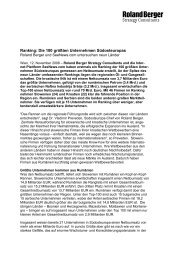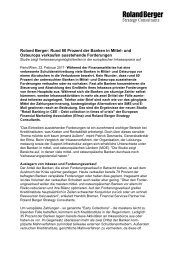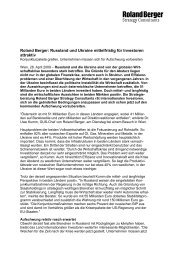Retail Banking in CEE: Exploiting the Potential of ... - Roland Berger
Retail Banking in CEE: Exploiting the Potential of ... - Roland Berger
Retail Banking in CEE: Exploiting the Potential of ... - Roland Berger
You also want an ePaper? Increase the reach of your titles
YUMPU automatically turns print PDFs into web optimized ePapers that Google loves.
20<br />
MICRO STRATEGIES – ELABORATING SEGMENTATION AND SERVICE MODEL<br />
Therefore banks that are not experienced <strong>in</strong> <strong>the</strong> micro segment should make <strong>the</strong>ir own<br />
local market evaluation, def<strong>in</strong>e strengths and opportunities and select two to three<br />
target sub-segments (compare fig. 11) to ga<strong>in</strong> experience <strong>in</strong> a first step. A clear classification<br />
<strong>of</strong> sub-segments <strong>in</strong>to mass and premium is <strong>the</strong> next step driv<strong>in</strong>g "cost to serve"<br />
(see details <strong>in</strong> <strong>the</strong> follow<strong>in</strong>g section), follow<strong>in</strong>g <strong>the</strong> scheme <strong>of</strong> <strong>the</strong> private clients. The<br />
private affluent side <strong>of</strong> <strong>the</strong> bank<strong>in</strong>g relationship is usually closely connected with <strong>the</strong><br />
bus<strong>in</strong>ess side.<br />
Healthcare pr<strong>of</strong>essions are <strong>the</strong> most<br />
attractive sub-segments – All four<br />
prioritized groups can be targeted <strong>in</strong><br />
a bundle<br />
Analyz<strong>in</strong>g <strong>the</strong> pr<strong>of</strong>essions more <strong>in</strong>-depth allows fur<strong>the</strong>r sub-segmentation (compare<br />
fig. 12).<br />
Based on <strong>the</strong> research, pr<strong>of</strong>essionals may be less attractive <strong>in</strong> terms <strong>of</strong> <strong>the</strong>ir sheer number.<br />
But <strong>the</strong>y can quite easily be captured with dedicated <strong>of</strong>fers. Healthcare-related pr<strong>of</strong>essions<br />
(medical doctors, dentists, pharmacists, veter<strong>in</strong>ary doctors) are most attractive<br />
segments by GI per client. O<strong>the</strong>r segments are less promis<strong>in</strong>g ma<strong>in</strong>ly due to <strong>the</strong>ir lower<br />
need for credit products and <strong>the</strong>ir possibly lower transaction traffic. At <strong>the</strong> same time,<br />
<strong>the</strong> four prioritized segments constitute <strong>the</strong> majority <strong>of</strong> potential pr<strong>of</strong>essional clients<br />
with medical doctors mak<strong>in</strong>g up almost 50%.<br />
From <strong>the</strong> banks' perspective, all free pr<strong>of</strong>essionals represent significant GI potential<br />
from sav<strong>in</strong>gs and <strong>in</strong>vestments <strong>in</strong> <strong>the</strong> later stages <strong>of</strong> <strong>the</strong>ir life cycle, e.g. medical pr<strong>of</strong>essionals<br />
shift from f<strong>in</strong>anc<strong>in</strong>g <strong>the</strong>ir bus<strong>in</strong>ess to private wealth management or o<strong>the</strong>r free<br />
pr<strong>of</strong>essionals accumulate wealth and demand <strong>in</strong>vestment products to ma<strong>in</strong>ta<strong>in</strong> private<br />
sav<strong>in</strong>gs.<br />
Generally retail & wholesale,<br />
production and construction are <strong>the</strong><br />
most attractive sectors <strong>in</strong> terms <strong>of</strong><br />
both volume and value per client<br />
In <strong>the</strong> group <strong>of</strong> small companies, <strong>the</strong> number <strong>of</strong> clients makes retail & wholesale <strong>the</strong><br />
largest segment by far. Production and construction lead <strong>in</strong> terms <strong>of</strong> value per client<br />
and <strong>of</strong> annual GI per client (compare fig. 13), followed by retail & wholesale and agriculture.<br />
Transportation, culture/sport/education and hospitality are smaller and thus<br />
low-priority segments but may show dist<strong>in</strong>ctive needs (e.g. leas<strong>in</strong>g <strong>in</strong> case <strong>of</strong> transportation).
















